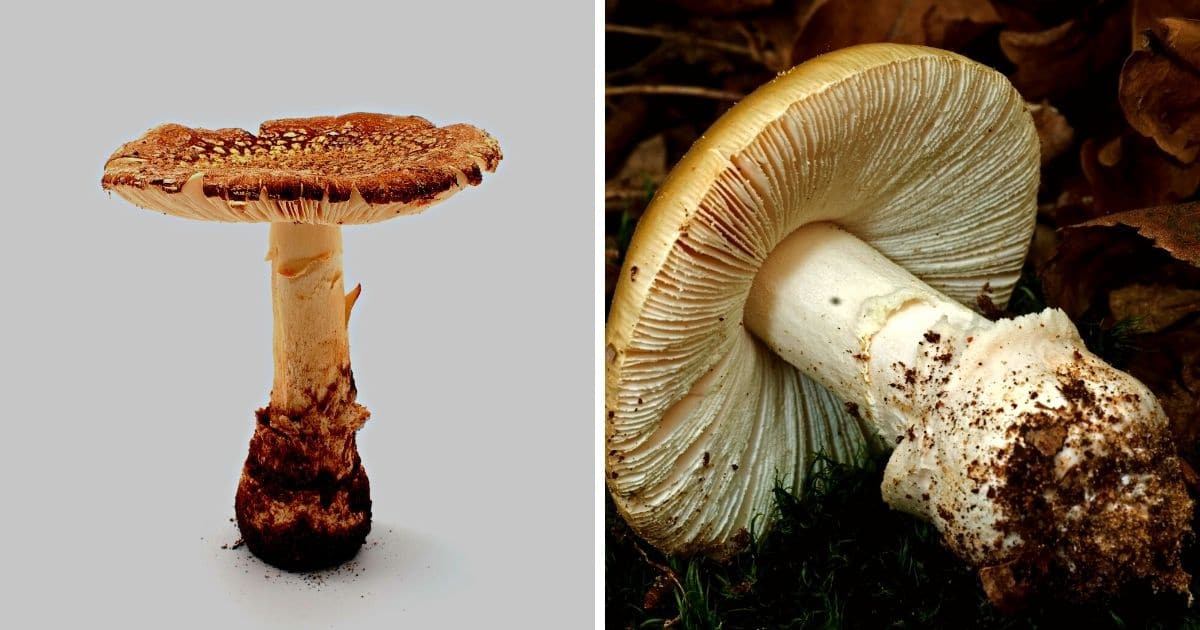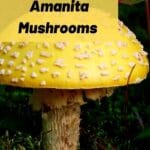Below you’ll find a list of common characteristics to help you identify poisonous mushrooms of the Amanita genus. This list is by no means the final word! Weather and other environmental factors can change the shape of a mushroom, making it difficult to identify.
So please remember that this is just a guide to supplement learning, which should be done through books and especially guided forays. Don’t eat any mushroom-based on what you’ve read here!
Jump to:
All About Amanita Mushrooms
An Amanita forms as a small button in the shape of an egg. The outside of the “egg” is actually a layer of tissue surrounding the mushroom known as the “universal veil”. Often it will have a “partial veil” as well, which is a layer of tissue that covers just the gills before the mushroom is old enough to produce spores. Eventually, these veils break as the mushroom grows.

During the young button phase, it’s easy to mistake an Amanita for a puffball. This is why it’s so important to slice open a puffball mushroom and check to make sure it’s solid inside. Finding gills indicates that it’s not a puffball at all, but possibly a deadly Amanita.
While not all amanitas are deadly, some contain the powerful toxin amanitin. Amanitin is thought to be the most lethal of all mushroom toxins and is found in both the death cap and the destroying angel. For an interesting article on how poisonous mushrooms produce amanitin see this article from Science News.
Amanita Description and Common Traits
Below are common traits that will help you identify these poisonous mushrooms (with some visual aids, of course!).
1. Warts or scales on the cap. Note the off-colored “patches” on the top of the cap. These are the remnants of the universal veil that surrounds the mushroom when it is young. Sometimes these patches look more like rows of raised dots.

2. A parasol or umbrella-shaped cap. Each of these pictures is a good example of how an amanita cap is shaped, convex like a wide, upside-down letter U. Or, for my fellow math enthusiasts, like an inverted parabola!

3. The presence of a bulbous cup or sac around the base. This rounded cup is called the “volva” and is another remnant of the universal veil. It is often under the ground so you may have to gently dig up the mushroom to see it.

4. A white spore print. When an amanita cap is placed face down on a dark-colored sheet of paper, it will often leave a spore print that is white.
5. The presence of a ring around the stem. This ring, called the “annulus”, is where the partial veil was attached to the stem before it tore apart as the mushroom grew.

6. Gills that are thin and white. The underside of this example shows the white gills of an Amanita. Just another thing to look for when trying to identify poisonous mushrooms.

Amanitas usually start appearing during the second half of the season, in summer and fall. Look for them in woodlands on the ground. In many places, they are quite common.
An Edible Amanita
There is one type of Amanita that is treasured as an incredibly delicious edible mushroom. This is the Caesar mushroom, and there are four species of Caesars in North America. This isn’t a mushroom for beginner foragers, but once you get more familiar with mushroom identification, it’s a good one to know.
Mushroom Identification Guides
Learning the basics of mushroom identification helps identify the poisonous and wonderfully edible species. Start with these guides to get down the basics, then make sure you get a book as back up. You should always confirm with 3-4 sources before consuming anything!
Be Safe!
Knowing how to identify poisonous mushrooms will go a long way towards the prevention of poisoning yourself. Although there are some deadly species (and many more that will just make you sick), with the right knowledge and common sense mushroom hunting isn’t as dangerous as some would believe. Remember to never eat anything that you haven’t positively identified at least three times.









Riley says
I have a question about amanitas, it seems you lump amanita muscaria in with the poisonous mushrooms, you don’t list it specifically, but you show pictures of it on your identifying poisonous amanitas section. Do you believe this specific variety of amanita to be poisonous?
Jenny says
There is a lot of controversy around this mushroom and we always err on the side of caution. This mushroom is poisonous. It probably won’t kill you, but you’ll feel very ill after eating A.muscaria if it is not properly cooked. There have been reported poisonings, usually from young kids eating a pretty mushroom they find. Or, from folks trying to have a hallucinogenic experience and just getting sick instead.
I know many cultures eat A.muscaria mushrooms after boiling them multiple times. But, unless you grow up knowing the technique and understanding how to prepare the mushroom to remove the toxins, it is not a good idea to eat it.
Thank you for the comment. I need to update that page to make it more clear about A.muscaria since that is the common “toadstool” mushroom everyone knows.
William Miller says
Does the amanita muscaria have psychedelic properties?
Jenny says
A little, maybe, it seems to vary by person. It’s a very small amount if it does exist. The main result after eating amanita muscaria is extreme gastrointestinal distress and vomiting.
Jeff says
How do I make sure this mushroom edible. My app identifies it as Jackson’s slender Caesar.
Tried to past pic but couldn’t
Jenny says
If you think it is a Caesar, you can consult this guide caesar mushrooms in the US
You can post pics in our facebook group — make sure you read the featured post and post all the info needed